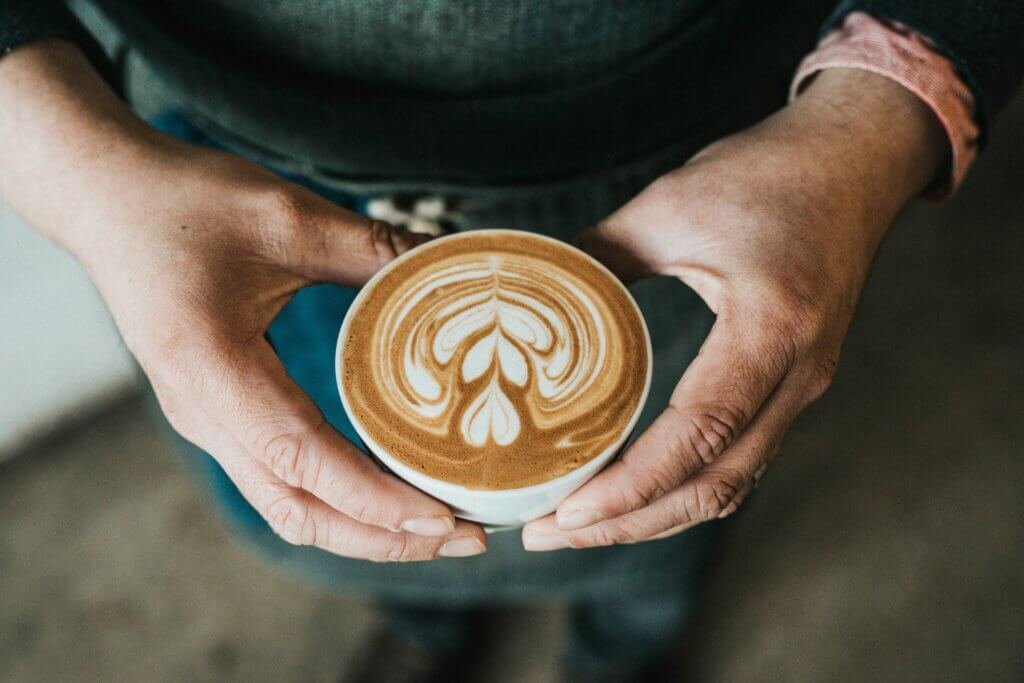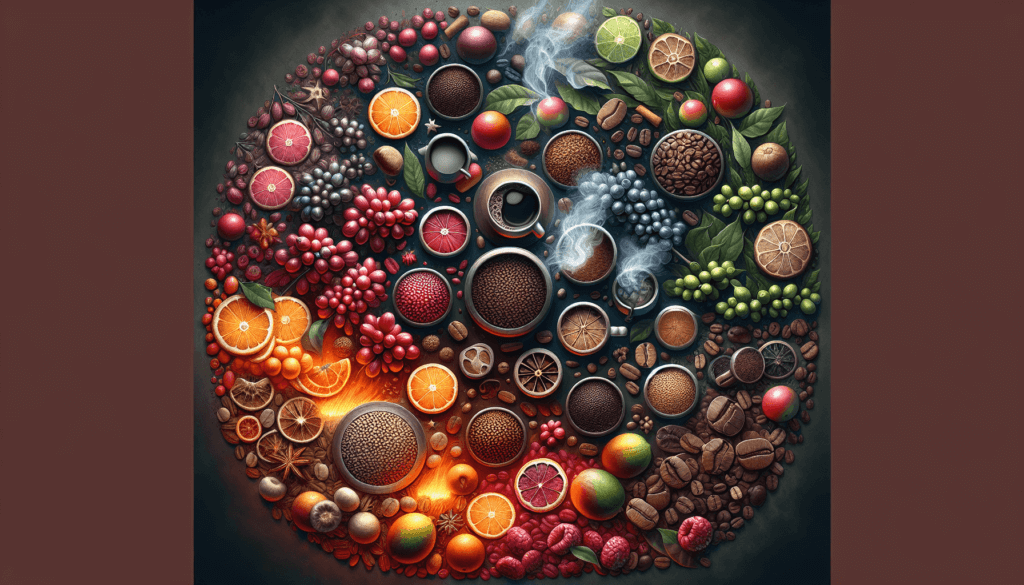So you’re curious about coffee flavor profiles? Look no further! This comprehensive guide will take you on a journey through the intricate world of coffee tasting, helping you unravel the secrets behind the flavors you love. From the bright and acidic to the bold and chocolaty, we’ll explore how different factors like origin, roast level, and brewing methods contribute to the unique taste experiences that coffee has to offer. By the end, you’ll be equipped with a deeper understanding of coffee’s diverse flavor profiles, empowering you to savor every sip with newfound appreciation. Get ready to embark on an aromatic adventure!

What are Coffee Flavor Profiles?
Defining coffee flavor profiles
Coffee flavor profiles refer to the various tastes and aromas that can be found in different types of coffee. Just like wine, coffee has its own unique set of flavor characteristics that can be described and analyzed. Understanding coffee flavor profiles allows you to appreciate and choose coffee based on your personal preferences.
Importance of understanding coffee flavor profiles
Understanding coffee flavor profiles is crucial for both coffee enthusiasts and professionals. It allows you to select coffee that aligns with your taste preferences, ensuring that each cup brings you joy and satisfaction. For professionals in the coffee industry, such as baristas or roasters, knowledge of flavor profiles is essential for creating well-balanced blends and providing customers with the best coffee experience possible.
Factors Affecting Coffee Flavor
Varieties of coffee beans
The variety of coffee bean used in a coffee affects its flavor profile. Arabica and Robusta are the two main varieties of coffee beans. Arabica is generally known for its delicate and complex flavors, while Robusta is often associated with a stronger and more bitter taste. Within each variety, there are also sub-varieties that contribute to differences in flavor. Factors such as the growing conditions, altitude, and processing methods also play a role in shaping the flavor of the beans.
Roasting process
The roasting process is another key factor that influences the flavor of coffee. Different roast levels, ranging from light to dark, produce distinct flavor profiles. Light roasts tend to retain more of the original flavors of the coffee bean, while darker roasts develop richer and bolder flavors through caramelization and the Maillard reaction. The duration and temperature of the roasting process also impact the final flavor.
Brewing methods
The brewing method used can greatly affect the flavor profile of coffee. Each brewing method extracts different compounds from the coffee grounds, resulting in varying taste profiles. For example, espresso brewing emphasizes body and intensity, while pour-over methods highlight the clarity and subtleties of the coffee’s flavors. By experimenting with different brewing techniques, you can uncover new aspects of a coffee’s flavor and find the perfect method to suit your taste preferences.
Storage conditions
Proper storage is essential for maintaining the freshness and flavor of coffee. Exposure to air, light, moisture, and heat can all degrade the quality of coffee beans and lead to a loss of flavor. It is recommended to store coffee beans in airtight containers in a cool, dark place. Avoid buying coffee in large quantities if you won’t consume it within a reasonable time frame, as freshness greatly impacts the taste of coffee.
Tasting Coffee Flavor Profiles
Developing a sensory vocabulary
To effectively describe and appreciate coffee flavors, it’s important to develop a sensory vocabulary. This involves training your taste buds and sense of smell to identify specific flavors. Start by tasting different foods and beverages that have distinct flavors, such as fruits, spices, and chocolates. Pay attention to the nuances and try to pinpoint specific flavors. By regularly practicing this exercise, you will become more adept at identifying and describing the flavors present in coffee.
Cupping and professional tasting
Cupping is a technique commonly used by professionals in the coffee industry to evaluate and compare different coffees’ flavor profiles. It involves slurping and spitting small amounts of coffee to assess its aroma, flavor, acidity, body, and aftertaste. Cupping sessions are often conducted in a controlled environment to eliminate external factors that could influence the perception of flavors. Engaging in cupping sessions or attending professional tasting events can greatly enhance your understanding and appreciation of coffee flavor profiles.
Home tasting techniques
You don’t need to be a professional to explore coffee flavor profiles at home. There are various techniques you can employ to enhance your tasting experience. Start by choosing a specific coffee and sample it side by side with others to compare flavors. Take note of the differences and similarities among the various coffees. Experiment with different brewing methods and try brewing the same coffee using multiple techniques to uncover new flavors. Allow yourself to focus on the taste, aroma, and mouthfeel of the coffee to fully immerse yourself in the experience.
Common Coffee Flavor Descriptors
When describing coffee flavor profiles, certain terms and descriptors are commonly used. These descriptors provide a language that enables coffee lovers to communicate their preferences and understand what to expect from a specific coffee. Here are some common flavor descriptors:
Fruity
Fruity flavors in coffee can range from bright and citrusy to rich and berry-like. Depending on the origin and variety of the coffee bean, you may taste notes of lemon, orange, grapefruit, blueberry, cherry, or even tropical fruits like pineapple.
Nutty
Nutty flavors are often associated with coffee. They can be reminiscent of almonds, peanuts, or hazelnuts. These flavors are typically found in medium to dark roast coffees.
Chocolaty
Chocolaty flavors in coffee evoke the richness and indulgence of chocolate. This can encompass anything from dark chocolate to milk chocolate and even cocoa powder.
Floral
Some coffees exhibit floral characteristics, similar to the aroma of flowers. These flavors can include jasmine, rose, lavender, or even the perfume-like fragrance of honeysuckle.
Herbal
Herbal flavors in coffee can resemble the aromas and tastes of various herbs and spices. Examples include mint, basil, thyme, and even chamomile.
Spicy
Spicy flavors can add complexity and warmth to coffee. Cinnamon, cloves, nutmeg, and cardamom are common examples of spices that can be found in coffee.
Caramel
Caramel flavors bring a sweet and buttery dimension to coffee. This can range from a subtle caramel note to a more pronounced caramelized sugar taste.
Acidity
Acidity refers to the brightness and liveliness present in coffee. It is not the same as sourness, but rather adds a desirable tanginess and vibrancy to the overall flavor profile.
Bitterness
Bitterness is a common aspect of coffee flavor. It can range from a pleasant, lingering dark chocolate bitterness to an undesirable, overpowering taste. Balancing bitterness with other flavors is key to a well-rounded coffee.

Exploring Different Coffee Origin Flavor Profiles
Distinct flavor profiles from different regions
Coffee beans from different regions around the world offer unique flavor profiles. Factors such as soil composition, climate, altitude, and cultivation techniques contribute to these distinctions. For example, coffees from Ethiopia are often highly fruity and floral, while those from Brazil tend to exhibit a nutty and chocolatey character. Exploring coffee beans from different origins allows you to appreciate the diversity and complexity of coffee flavors.
Notable coffee regions and their flavors
Here are some notable coffee regions and the flavor profiles commonly associated with them:
- Ethiopia: Fruity, floral, and tea-like flavors with notes of citrus, berries, and jasmine.
- Colombia: Balanced and mild with medium acidity and flavors of caramel, chocolate, and nuts.
- Brazil: Nutty and chocolatey with low acidity, often exhibiting flavors of nuts, cocoa, and caramel.
- Costa Rica: Bright acidity and flavors ranging from citrus fruits to honey and brown sugar.
- Jamaica: Highly prized for its Blue Mountain coffee, which offers a delicate and complex profile with mild acidity, rich flavors, and a smooth body.
Exploring coffee from various regions allows you to broaden your palate and discover new coffee flavor profiles that align with your preferences.
Understanding Coffee Roast Levels
Light roast
Light roast coffee is typically light brown and has a subtle flavor profile. It retains most of the natural flavors of the coffee beans, showcasing their unique characteristics. Light roasts generally have higher acidity and a lighter body.
Medium roast
Medium roast coffee is a balance between light and dark roasts. It presents a more developed flavor profile than light roasts, with a slightly richer body. Medium roasted coffees often exhibit a complexity of flavors, combining both the inherent characteristics of the beans and the caramelization that occurs during roasting.
Dark roast
Dark roast coffee is roasted for a longer period, resulting in a darker color and more pronounced flavors. Dark roasts are known for their bold and intense flavors, with lower acidity and a fuller body. The longer roasting time imparts smoky and roasted notes, sometimes with hints of bitterness.
Degrees of roast and their impact on flavors
The degree of roast directly impacts the flavors and characteristics of coffee beans. As coffee beans are roasted longer, the natural flavors are transformed, and new flavors emerge through the Maillard reaction and caramelization. Light roasts allow the natural flavors to shine through, while darker roasts introduce bolder and more complex flavors. Finding the roast level that aligns with your preferred flavor profile is a key aspect of enjoying coffee.

Matching Coffee Flavor Profiles with Food
Complementary flavors
Pairing coffee with food can enhance the overall culinary experience by matching flavors that complement each other. By choosing coffees with flavors that harmonize or contrast with specific food items, you can create a delightful symphony of tastes. For example, the fruity and floral notes of a lightly roasted Ethiopian coffee can beautifully complement a slice of citrusy lemon cake.
Contrasting flavors
Contrasting flavors can also create interesting tasting experiences. Pairing a rich and chocolaty coffee with a tangy key lime pie can create a satisfying balance between sweetness and acidity. Experimenting with different combinations allows you to discover unique flavor combinations that surprise and delight your taste buds.
Pairing coffee with various food items
Here are some general guidelines for pairing coffee with different food items:
- Fruity coffees: Pair well with fruit-based desserts, citrusy pastries, and light salads.
- Nutty coffees: Complement chocolate-based desserts, nut pies, and roasted meats.
- Chocolaty coffees: Enhance the flavors of chocolate cakes, brownies, and other chocolate desserts.
- Floral coffees: Pair nicely with floral-infused pastries, honey-based sweets, and herbal teas.
- Herbal and spicy coffees: Complement spiced cakes, gingerbread, and rich, savory dishes.
Don’t be afraid to experiment and trust your palate when pairing coffee with food. The key is to find combinations that you personally enjoy.
Adjusting Brewing Methods to Enhance Coffee Flavors
Grind size and extraction
The grind size of coffee beans significantly affects the extraction process and, consequently, the resulting flavor profile. Finer grinds increase the surface area and allow for quicker extraction, resulting in a more intense and flavorful cup of coffee. Coarser grinds require longer extraction times and can produce a smoother and less pronounced flavor profile. Experimenting with different grind sizes can help you find the sweet spot that aligns with your desired flavor intensity.
Water temperature and brewing time
Water temperature and brewing time are critical variables when it comes to extracting flavors from coffee beans. Different temperature ranges and brewing times can bring out different flavors and intensities. Generally, a water temperature between 195°F and 205°F (90°C to 96°C) is recommended for most brewing methods. Adjusting the brewing time can also impact the strength and flavor profile of the coffee. Longer brewing times can result in a bolder and more intense cup, while shorter times may yield a lighter and more delicate coffee.
Alternative brewing methods
Traditional brewing methods like drip brewing or espresso are not the only options for experimenting with coffee flavor profiles. Alternative brewing methods, such as French press, pour-over, AeroPress, or cold brew, offer unique flavor experiences. These methods provide different extraction techniques that can highlight specific flavors or produce a different mouthfeel. Exploring alternative brewing methods can open up a whole new world of coffee flavors.

The Role of Coffee Beans’ Quality and Freshness in Flavor
How bean quality affects flavor
The quality of coffee beans directly impacts the flavor and overall taste experience. Higher-quality beans, often from specific regions or farms, tend to showcase exceptional and distinct flavor profiles. Factors such as growing conditions, harvesting methods, and bean selection contribute to bean quality. Specialty coffee beans, for example, are known for their superior quality and exceptional flavor characteristics. Choosing beans from reputable sources and understanding the quality grading systems can ensure you’re enjoying the best flavors coffee has to offer.
The impact of freshness on coffee taste
Freshness plays a crucial role in the flavor of coffee. Coffee beans naturally release aromatic compounds, and as they age, these compounds degrade, resulting in a loss of flavor. It is recommended to purchase whole beans and grind them just before brewing to maximize freshness. Additionally, consuming coffee within a few weeks of the roast date ensures that you experience the full range of flavors. Proper storage, as mentioned earlier, also helps maintain the freshness of the beans and preserves their flavor profiles.
Expanding Your Coffee Flavor Profile Knowledge
Exploring different coffee blends
Coffee blends are created by combining beans from multiple origins to achieve a desired flavor profile. Exploring different blends allows you to discover unique flavor combinations and expand your palate. Blends can offer a balanced and well-rounded cup of coffee or showcase specific flavor profiles. Some blends are designed to highlight fruity or nutty flavors, while others aim for a darker and bolder profile. By trying out different blends, you can further refine your understanding of coffee flavor profiles.
Participating in cupping events and workshops
Cupping events and workshops provide opportunities to taste and learn about various coffee flavor profiles under the guidance of industry professionals. These events often involve cupping sessions, where you can compare and analyze different coffees side by side. Participating in cupping events and workshops can help you develop a deeper understanding of coffee flavors and improve your sensory vocabulary. It’s also a great way to connect with fellow coffee enthusiasts and expand your network within the coffee community.
Engaging with coffee communities online
The online coffee community is a treasure trove of knowledge and experiences. Engaging with coffee communities through forums, social media platforms, or online coffee groups allows you to learn from and interact with like-minded individuals. Sharing tasting notes, discussing flavor profiles, and exchanging recommendations can provide valuable insights and expand your coffee flavor profile knowledge. Online platforms also provide access to resources such as blogs, podcasts, and videos that offer further exploration into the world of coffee flavor profiles.
In conclusion, understanding coffee flavor profiles is essential for discovering and enjoying the diverse range of flavors that coffee has to offer. By familiarizing yourself with the factors that affect coffee flavor, developing your sensory vocabulary, and experimenting with different brewing methods and pairing options, you can embark on a delightful journey of coffee exploration. Whether you’re a coffee enthusiast seeking new taste experiences or a professional in the coffee industry, the world of coffee flavor profiles is yours to explore, savor, and share. Cheers to your endless coffee adventures!



